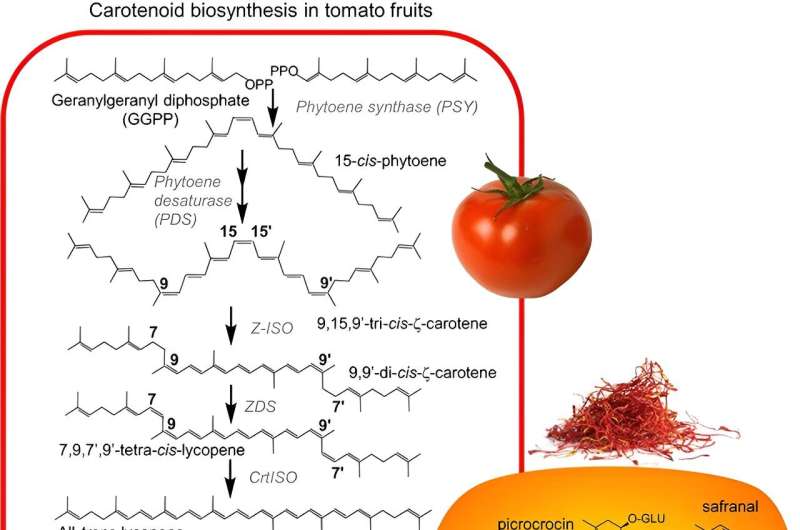This article has been reviewed according to Science X's editorial process and policies. Editors have highlighted the following attributes while ensuring the content's credibility:
fact-checked
peer-reviewed publication
proofread
Engineering tomatoes for high-yield saffron apocarotenoid production

Apocarotenoids, derived from the oxidative cleavage of carotenoids by carotenoid cleavage dioxygenases (CCDs), are crucial for biological functions in plants and animals, though their definition varies among scientific communities. In plant carotenoid biosynthesis, enzymes convert isoprenoids into carotenoids, leading to products like lycopene, lutein, and zeaxanthin, which play roles in photoprotection and detoxification.
Zeaxanthin is a precursor for apocarotenoids like crocins in saffron, contributing to its color, taste, and aroma. While saffron cultivation is labor-intensive and costly, advancing metabolic engineering and synthetic biology offer promising solutions for cost-effective production.
Current research focuses on extending the carotenoid pathway in alternative hosts like tomatoes, aiming to resolve traditional cultivation's high-cost and environmental challenges and to explore the potential of these compounds in various industries.
Horticulture Research published research titled "Engineering high levels of saffron apocarotenoids in tomato."
In this study, researchers harnessed the natural carotenoid accumulation in tomato fruits to produce saffron's distinctive apocarotenoids, aiming to boost the nutraceutical properties of tomato-based products. They employed a combinatorial genetic approach by introducing the saffron genes CsCCD2L, CsUGT2, and UGT709G1 into tomatoes using fruit-specific and constitutive promoters to optimize expression.
Although not all transgenic lines were viable, those that produced fruits demonstrated higher antioxidant activities and distinct apocarotenoid profiles when compared to wild-type. Detailed analyses revealed that lines differed in the accumulation of crocins, picrocrocin, and other compounds, with certain lines outperforming others based on specific metabolite levels.
While the overall carotenoid content in transgenic fruits was reduced, the enhanced accumulation of valuable apocarotenoids like crocins and picrocrocin was a significant trade-off. This transformation also affected the volatile compound profile, introducing novel apocarotenoid-derived volatiles and altering existing ones.
The study extended to evaluate these engineered tomatoes' health benefits and industrial potential. The transgenic tomatoes showed an increased antioxidant capacity and a neuroprotective effect against Alzheimer's in C. elegans, highlighting their potential as a functional food.
The researchers also explored the feasibility of using these tomatoes as a cost-effective alternative to traditional saffron production. They found that the engineered tomatoes could potentially substantially reduce production costs for saffron apocarotenoids, thereby addressing the economic and fraud issues associated with saffron cultivation.
In conclusion, this study successfully utilized tomatoes as a biotechnological platform to produce saffron apocarotenoids, leading to fruits with enhanced nutritional and therapeutic properties. The findings open avenues for using metabolic engineering in crops to produce valuable compounds affordably and sustainably, with broad implications for agriculture, industry, and health.
More information: Oussama Ahrazem et al, Engineering high levels of saffron apocarotenoids in tomato, Horticulture Research (2022). DOI: 10.1093/hr/uhac074
Journal information: Horticulture Research
Provided by Plant Phenomics





















